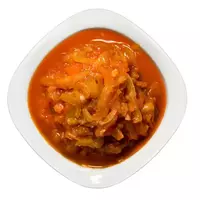Lecso

Lecho got its original name thanks to a classic dish of Hungarian national cuisine called lecso. It is noteworthy that lecho is popular not only in its historical homeland in Hungary. European and domestic hostesses have long adopted the lecho recipe. In autumn, gardeners and gardeners collect a rich crop of vegetables that you want to prepare for the winter in order to "recharge" vitamins and useful natural compounds from them in the cold season. Lecho is a great way to harvest fresh vegetables for future use.
Composition of lecho
It should be noted that as such, a single recipe or composition of lecho simply does not exist. The thing is that each hostess prepares a dish according to her own recipe. Fortunately, various types of vegetables are suitable for lecho. However, the composition of lecho will necessarily contain three main ingredients - tomatoes, preferably strongly ripened, bell peppers and onions.
The calorie content of the lecho is at a very low level and is only 89 Kcal per 100 grams of vegetable product. This did not happen the low caloric content of the lecho is explained by the recipe dish. For the manufacture of lecho, only vegetable ingredients are used. Most vegetables are considered low-calorie and dietary foods. Therefore, lecho can also be safely attributed to dietetic, and most importantly, healthy foods.
Benefits of lecho
The benefits of treatment lie in the chemical composition of the dish. In the composition of lecho, you can find vitamins of groups C, B, A and C, as well as magnesium, zinc, selenium, potassium, phosphorus and iron. Interestingly, the chemical composition of useful natural compounds, as well as the caloric content of lecho, can change depending on the composition of the initial ingredients of the dish. In addition to the invaluable benefits of curing for human health, the product is considered a tasty vegetable dish that enjoys well-deserved popularity.
In Germany, for example, lecho is used as a side dish for meat dishes and sausages. In Hungary, lecho is considered an independent national dish. Usually lechos are cooked in large dishes for the whole family. A few minutes before readiness, the eggs are added to the vegetables and mixed. Hungarian lecho is served with plenty of white bread. Such a dish is somewhat reminiscent of the Swiss Fondue, but instead of cheese they use tasty and healthy lecho.
In order to make lecho at home, you will need a simple set of initial ingredients. So, take two kilograms of sweet pepper and tomatoes, a kilogram of onions, vegetable oil, sugar, salt, pepper and other seasonings to taste. Usually black and allspice are added to lecho, as well as bay leaves. Some hostesses make lechos with 9% vinegar.
Vegetables should be washed well, tomatoes should be scrolled through a meat grinder or milled with a blender. Cut the peppers into straws and the onions into half rings. Then mix the vegetables, add the spices and simmer over a low heat for about an hour. At the final stage, vinegar is added to the lecho, and then the product is laid out in pre-sterilized jars, and then covered with lids. A healthy and tasty lecho product is ready for wintering.
lecho 89.2 kCal
Energy value of lecho (Ratio of proteins, fats, carbohydrates - ju):
Proteins: 1 g (~ 4 kCal)
Fats: 6.9 g (~ 62 kCal)
Carbohydrates: 6.1 g (~ 24 kCal)
Energy ratio (bj | y): 4% | 70% | 27%
 Español
Español Français
Français Português
Português Русский
Русский 简体中文
简体中文 繁體中文
繁體中文 日本語
日本語 한국어
한국어 العربية
العربية Türkçe
Türkçe Қазақ
Қазақ Deutsch
Deutsch Italiano
Italiano Українська
Українська
